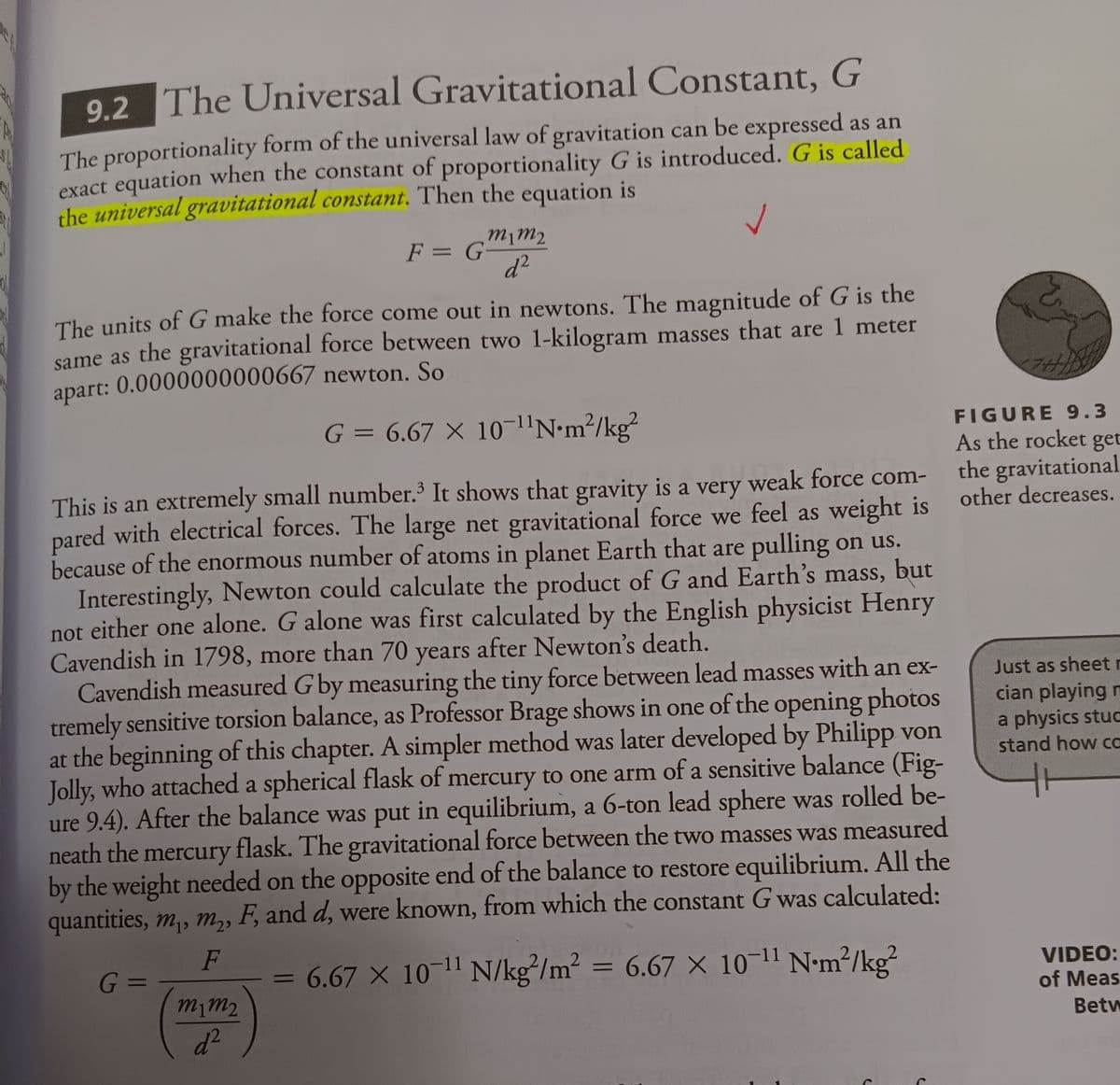Physics for Scientists and Engineers: Foundations and Connections
1st Edition
ISBN:9781133939146
Author:Katz, Debora M.
Publisher:Katz, Debora M.
Chapter7: Gravity
Section: Chapter Questions
Problem 14PQ: Since 1995, hundreds of extrasolar planets have been discovered. There is the exciting possibility...
Related questions
Question
100%
I don't understand where g=6.667*10^-11N*m^2/kg^2 comes from.
Can you help me understand how the book came up with that equation?

Transcribed Image Text:9.2 The Universal Gravitational Constant, G
The proportionality form of the universal law of gravitation can be expressed as an
exact equation when the constant of proportionality G is introduced. G is called
the universal gravitational constant. Then the equation is
The units of G make the force come out in newtons. The magnitude of G is the
same as the gravitational force between two 1-kilogram masses that are 1 meter
apart: 0.0000000000667 newton. So
G = 6.67 X 10-¹¹N•m²/kg²
This is an extremely small number.³ It shows that gravity is a very weak force com-
pared with electrical forces. The large net gravitational force we feel as weight is
because of the enormous number of atoms in planet Earth that are pulling on us.
Interestingly, Newton could calculate the product of G and Earth's mass, but
not either one alone. G alone was first calculated by the English physicist Henry
Cavendish in 1798, more than 70 years after Newton's death.
m1m2
F = G-
d²
m1m₂
d²
Cavendish measured G by measuring the tiny force between lead masses with an ex-
tremely sensitive torsion balance, as Professor Brage shows in one of the opening photos
at the beginning of this chapter. A simpler method was later developed by Philipp von
Jolly, who attached a spherical flask of mercury to one arm of a sensitive balance (Fig-
ure 9.4). After the balance was put in equilibrium, a 6-ton lead sphere was rolled be-
neath the mercury flask. The gravitational force between the two masses was measured
by the weight needed on the opposite end of the balance to restore equilibrium. All the
quantities, m₁, m₂, F, and d, were known, from which the constant G was calculated:
F
G =
6.67 × 10-¹1 N/kg/m² = 6.67 x 10-¹¹ Nm²/kg²
-
2
y
FIGURE 9.3
As the rocket get
the gravitational
other decreases.
Just as sheet r
cian playing m
a physics stuc
stand how ca
VIDEO:
of Meas
Betw
Expert Solution
This question has been solved!
Explore an expertly crafted, step-by-step solution for a thorough understanding of key concepts.
This is a popular solution!
Trending now
This is a popular solution!
Step by step
Solved in 3 steps with 5 images

Knowledge Booster
Learn more about
Need a deep-dive on the concept behind this application? Look no further. Learn more about this topic, physics and related others by exploring similar questions and additional content below.Recommended textbooks for you

Physics for Scientists and Engineers: Foundations…
Physics
ISBN:
9781133939146
Author:
Katz, Debora M.
Publisher:
Cengage Learning

Classical Dynamics of Particles and Systems
Physics
ISBN:
9780534408961
Author:
Stephen T. Thornton, Jerry B. Marion
Publisher:
Cengage Learning

College Physics
Physics
ISBN:
9781938168000
Author:
Paul Peter Urone, Roger Hinrichs
Publisher:
OpenStax College

Physics for Scientists and Engineers: Foundations…
Physics
ISBN:
9781133939146
Author:
Katz, Debora M.
Publisher:
Cengage Learning

Classical Dynamics of Particles and Systems
Physics
ISBN:
9780534408961
Author:
Stephen T. Thornton, Jerry B. Marion
Publisher:
Cengage Learning

College Physics
Physics
ISBN:
9781938168000
Author:
Paul Peter Urone, Roger Hinrichs
Publisher:
OpenStax College

University Physics Volume 1
Physics
ISBN:
9781938168277
Author:
William Moebs, Samuel J. Ling, Jeff Sanny
Publisher:
OpenStax - Rice University